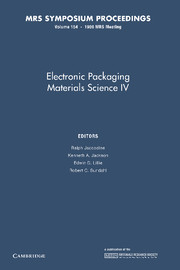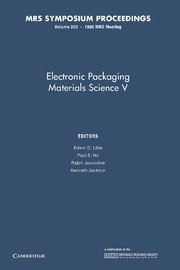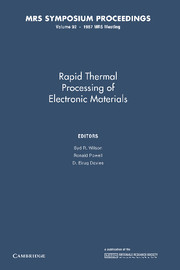Electronic Basis of the Strength of Materials
- Author: John J. Gilman, University of California, Los Angeles
- Date Published: December 2004
- availability: This ISBN is for an eBook version which is distributed on our behalf by a third party.
- format: Adobe eBook Reader
- isbn: 9780511059667
Find out more about Cambridge eBooks
$
69.99 USD
Adobe eBook Reader
Other available formats:
Paperback, Hardback
Looking for an inspection copy?
This title is not currently available for inspection. However, if you are interested in the title for your course we can consider offering an inspection copy. To register your interest please contact [email protected] providing details of the course you are teaching.
-
This 2003 book relates the complete set of strength characteristics of constituent atoms to their electronic structures. These relationships require knowledge of both the chemistry and physics of materials. The book uses both classical and quantum mechanics, since both are needed to describe these properties, and begins with short reviews of each. Following these reviews, the three major branches of the strength of materials are given their own sections. They are: the elastic stiffnesses; the plastic responses; and the nature of fracture. This work will be of great value to academic and industrial research workers in the sciences of metallurgy, ceramics, microelectronics and polymers. It will also serve well as a supplementary text for the teaching of solid mechanics.
Read more- First ever book to relate the strength properties of a material to its electronic structure
- Discusses both the physics and chemistry of materials
Reviews & endorsements
Review of the hardback: 'An invaluable read for academic and industrial research workers in the sciences of metallurgy, ceramics and microelectronics.' Materials World Including International Mining and Materials
See more reviewsReview of the hardback: 'A comprehensive review of the relationship between the electronic structures of solids, and the microscopic and macroscopic mechanical properties of solid materials. An invaluable read for academic and industrial research workers in the sciences of metallurgy, ceramics and microelectronics.' Materials World
Review of the hardback: '… Gilman, in his new book, offers his unique perspective to provide simple, unifying concepts that connect a variety of observations … Electronic Basis of the Strength of Materials is a worthy read.' Physics Today
Review of the hardback: 'Gilman's book … represents an impressive accomplishment. It connects bonding with elasticity, plasticity, and fracture of materials. It does this at a level that can be comfortably assimilated by a graduate student, avoiding unnecessary esoteric convolutions of theory and explaining basic facts that are avoided in other textbooks.' MRS Bulletin
Customer reviews
Not yet reviewed
Be the first to review
Review was not posted due to profanity
×Product details
- Date Published: December 2004
- format: Adobe eBook Reader
- isbn: 9780511059667
- contains: 10 b/w illus.
- availability: This ISBN is for an eBook version which is distributed on our behalf by a third party.
Table of Contents
Part I. Introduction: Part II. Elements of Solid Mechanics:
1. Nature of elastic stiffness
2. Generalized stress
3. Generalized strain
4. Elastic coefficients
Part III. Elements of Electron Mechanics:
5. Properties of electrons
6. Quantum states
7. Periodic patterns of electrons
8. Heisenberg's Principle
Part IV. Elastic Stiffness:
9. Cohesion of atoms
10. Intramolecular cohesion
11. Intermolecular cohesion
12. Bulk modulus
13. Shear moduli
14. Entropic elasticity (polymers)
15. Universality and unification
Part V. Plastic Strength:
16. Macroscopic plastic deformation
17. Microscopic plastic deformation
18. Dislocation mobility
Part VI. Fracture Resistance:
19. Mechanics of cracks
20. Surface and interfacial energies
21. Fracturing rates.
Sorry, this resource is locked
Please register or sign in to request access. If you are having problems accessing these resources please email [email protected]
Register Sign in» Proceed
You are now leaving the Cambridge University Press website. Your eBook purchase and download will be completed by our partner www.ebooks.com. Please see the permission section of the www.ebooks.com catalogue page for details of the print & copy limits on our eBooks.
Continue ×Are you sure you want to delete your account?
This cannot be undone.
Thank you for your feedback which will help us improve our service.
If you requested a response, we will make sure to get back to you shortly.
×









